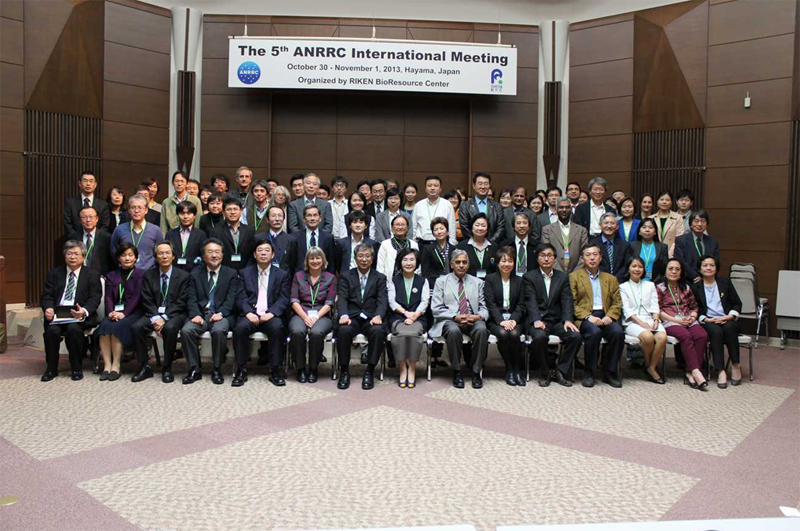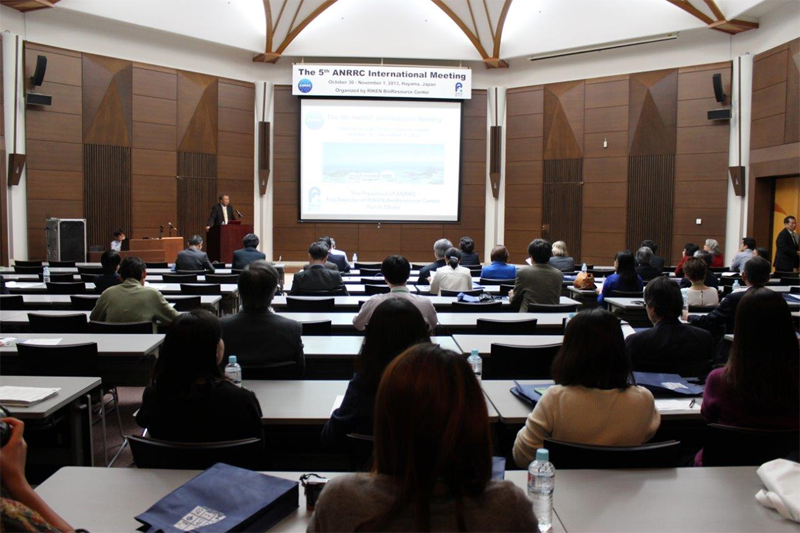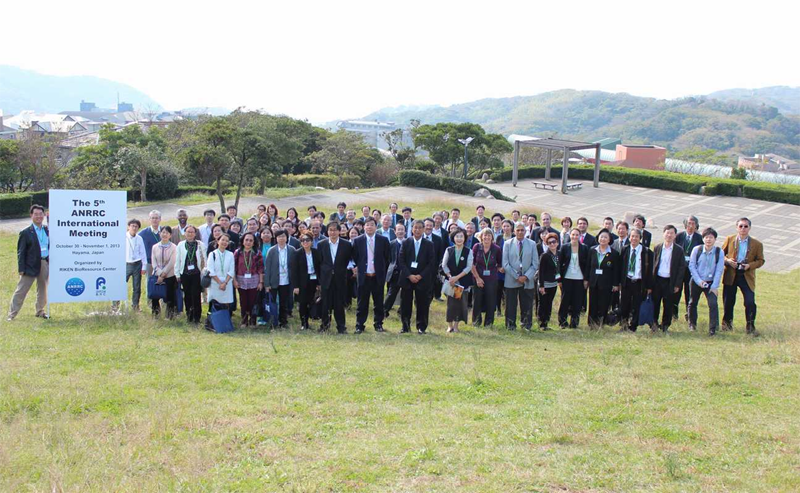Report of the 5th Meeting of the Asian Network of Research Resource Centers
The Asian Network of Research Resource Centers (ANRRC) was established to form a network of Asian research resource centers in order to improve their activities to accomplish their ultimate common goal that is to promote science, technology and innovation in Asia. RIKEN BioResource Center (RIKEN BRC) hosted the ANRRC 5th Meeting in Shonan Village Center (Hayama Kanagawa, Japan) from October 30 to November 1, 2013, with the cooperation of the National BioResource Project (NBRP) of the Japanese Ministry of Education, Culture, Sports, Science and Technology (MEXT).
There were 128 participants from 77 Asian organizations in 15 countries. Meeting consisted of "Report from Each Institute" with seven status reports by the representative from each institute and 33 oral presentations in the sessions of "Biodiversity" (3 titles), "Biobanking" (6), "Plant (4)", "Data Management (5)", "Microbe (5)", "Animal (5)", and "Alga (5)" as well as 49 poster presentations. During the Meeting, three companies were participated in a bioindustry exhibition. In addition, meetings were held by IT Committee, Biobanking Committee as well as Biodiversity Committee and International Affairs Committee both of which were newly established.
The Executive Board amended the article of the ANRRC Charter with respect to the approval of a new Executive Board member. Also, the Executive Board members drafted a statement for the Nagoya Protocol, requesting the use of genetic resources in non-profit academic research to be excluded or at least relaxed from the provisions of the Protocol, which all the 11 members from 9 countries agreed upon and signed.
The 6th meeting is scheduled to take place in China.
Session summaries
Opening & Plenary Lectures
Dr. Yuichi Obata, Director of RIKEN BRC, and Mr. Hiroshi Furuta, Director for Genome Research,Life Science Division, Research Promotion Bureau of the MEXT welcomed all participants and gave opening remarks. Dr. Yeonhee Lee, Director General of Korea National Research Resource Centers (KNRRC)gave a lecture entitled "The first 5 years of ANRRC", followed by a lecture by Dr. Oeda, Executive Director of RIKEN entitled "Japan's leading comprehensive research institution for the natural science."
Report from Each Institute
Chair: Dr. Yuichi Obata (RIKEN BRC) and Dr. Yeonhee Lee (KNRRC)
Member institutes in Korea, Thailand, Philippines, Japan, China, Australia, and Indonesia reported their current status. Dr. Yeonhee Lee, Director General of KNRRC gave a report on recent activities in KNRRC. Dr. Lily Eurwilaichitr (Bioresources Technology Unit, National Center for Genetic Engineering and Biotechnology: BIOTEC, Thailand) overviewed culture collections in Thailand. Dr. Maria Auxilia T. Siringan (Natural Science Research Institute, Philippines) summarized their studies on microorganisms in aquatic environment in the Philippines. Dr. Yuji Kohara (National Institute of Genetics, Japan) made a status report on the MEXT NBRP. After coffee break, Dr. Juncai Ma (Institute of Microbiology, Chinese Academy of Sciences: IMCAS, China) described recent development of his Center. Dr. Jane Carpenter (University of Sydney, Australia) introduced the Australian Biospecimen Network Association (ABNA), the Australian Breast Cancer Tissue Bank (ABCTB) and the International Society for Biological and Environmental Repositories (ISBER). Dr. Endang SR Hardjolukito (University of Indonesia - Cipto Mangunkusumo Hospital, Indonesia) talked about how they were paving the way for research biobanking in Indonesia.
Session 1. Biodiversity
Chair: Dr. Shyam Kumar Sharma (CSIR-Institute of Himalayan Bioresource Technology, India)
Session 1 consisted of three reports. Dr. Shyam Kumar Sharma who chaired the session reported issues of concern in the area of bioresources in India. Asia is a region with a high concentration of biodiversity hotspots, and India contains 3 of the 34 global hotspots. Since the Convention on Biological Diversity (CBD) entered into effect in 1993, India has been deeply concerned that her bioresources are always underestimated compared to their original value, insisting that they should be properly priced. India requests that she concludes mutually agreed terms (MAT) when she provides her bioresources based on the CBD. Dr. Mutsuaki Suzuki (National Institute of Genetics, Japan) asked Dr. Sharma how India would deal with the request of resources by academic entities, to which Dr. Sharma answered that India would offer her materials to overseas institutions with no charge under collaborative research project based on a mutual agreement. Dr. Le Mai Huong (Institute of Natural Products Chemistry, Vietnam) reported current status in Vietnamese bioresources. Specifically, he described their quest for biologically active compounds derived from mushrooms or marine organisms and also reported the compounds that have been commercialized. Dr. Suzuki told that the Nagoya Protocol is still under discussion toward implementation in Japan. The terms "biological resources" and "genetic resources" have not been clearly defined among the non-native English speaking countries.He also said that only 25 countries have confirmed the Nagoya Protocol while 193 countries have ratified the CBD up to now, and that EU plans to ratify the Protocol by the end of July 2014. If ratified by EU governments, the parties involved will soon reach the 50 countries needed for the Protocol to come into effect, Japan has just started discussion on domestic measure for the implementation of the Protocol. Dr. Suzuki insisted that genetic resources should be offered for free if requested for research purpose.
Unfortunately, there were only eight participants besides the speakers in this session, and discussion was not very actively. Dr. Sharma called for more participants during the "Report from Committee and Session Chairs" on the last day of the Meeting.
Session 2. Biobanking
Chair: Dr. Soo Yong Tan (Singhealth Tissue Repository, Singapore)
Session 2 consisted of six reports on current status of each institute as well as future actions for information management and quality improvement in the field of biobanking. Dr. Katja Eydeler (STARLIMS, Singapore) reported why cloud-based laboratory management system (LIMS) is ideal against the challenges for biobanking such as ever growing sample volume and increasing demand for high quality. Scientists involved in biobanking from each country including Dr. Menghong Sun (Fudan University China), Dr. Bong Kyung Shin (Korea Human Biobank Network, Korea University Guro Hospital, Korea), Dr. Soo-Yong Tan (SingHealth Tissue Repository, Singapore), and Dr. Anwar Ali Siddiqui (Aga Khan University, Pakistan) gave status reports on the issues pertaining to acquisition of human-derived biospecimen. It revealed that they all share common issues on the content of informed consent form and that they all realized the importance of getting the support from hospitals,especially from pathologists for securing the quality of specimens. Moreover, discussion was active on how to make biobanks financially sustainable, how to give incentive to their supporters, and how to deal with intellectual property rights. Furthermore, Dr. Tim Sheehy (Promega, USA) introduced automated high-throughput sample processing system.
Session 3. Plant
Chair: Dr. Masatomo Kobayashi (RIKEN BRC, Japan)
Session 3 consisted of four reports.Dr. Shuhei Nasuda (Kyoto University, Japan) overviewed the history of wheat genetics resources and reported present status on their collection. Specifically, he told that wheat genome sequencing has made a great advance in recent years despite of difficulty associated with three types of wheat genomes designated as "A", "B", and "D" and that establishment of core collection which covers total genetic diversity in wheat has been in progress as scheduled. Dr. Jung A Kim (Korea Brassica Genome Resource Bank, Korea) summarized their Korea Brassica Genome Sequencing Project, reporting that they have collected over 10,000 seeds of various Brassica species and that they developed molecular markers, especially for identifying species with pest and disease resistance. Dr. Eiji Nitasaka (Kyushu University) overviewed history and present status of their ipomoea nil (morning glory) resources collection. He also reported application of knowledge from morning glory as a model organism to the study of sweet potato. Dr. Toshihiro Kobayashi talked about collection and maintenance of plant cultured cells in RIKEN BRC. He introduced an advanced cryopreservation method for plant cultured cells, which has been quite challenging.
Session 4. Data Management
Chair: Dr. Juncai Ma (IMCAS, China)
Session 4 consisted of five reports from four countries. Dr. Ma introduced the Analyzer of Bio-Resources Citation (ABC), Dr. Yukiko Yamazaki (National Institute of Genetics, Japan) demonstrated their integrated database of NBRP resources. Dr. Kiejung Park (Korean Bioinformation Center (KOBIC, Korea) reported their activities in his insutitute. Dr. Supawadee Ingsriswang (BIOTEC, Thailand) talked about VacciKnowlogy and ChemEx. Dr. Haejin Lee (KNRRC, Korea) reported Data Management system in KNRRC.
Session 5. Microbe
Chair: Dr. Moriya Ohkuma (RIKEN BRC, Japan)
Session 5 donosisted of five reports from four countries. Dr. Moriya Ohkuma reported activities of RIKEN BRC-JCM. Dr. Ken-ichiro Suzuki (NITE Biological Resource Center, Japan) made a status report on an international collaborative project with Indonesia called "Science and Technology Research Partnership for Sustainable Development" (SATREPS). Dr. Yu-Guang Zhou (IMCAS, China) gave a talk about recent activities of China General Microbiological Culture Collection Center (CGMCC). Dr. Chatrudee Suwannachart (Thailand Institute of Scientific and Technological Research (TISTR, Thailand) reported their activities. Dr. Iftikhar Ahmed (National Culture Collection of Pakistan, Pakistan) reported current status of the microbial culture collection in Pakistan.
Session 6. Animal
Chair; Dr. Hideaki Maekawa (NBRP, Japan)
Session 6 consisted of five reports pertaining to mite, medaka, and silkworm. There were reports on mite collections from Korea and Thailand. Dr. Tai-Soon Yong (Arthropods of Medical Importance Resource Bank (AMIB), Korea) introduced their activities. He also reported their Official Development Assistance (ODA) project in progress. He said that they identified a new hard tick of medical importance in Tanzania and that they would establish an infrastructure of bioresource centers in Tanzania. Dr. Nat Malainual (Mahidol University, Thailand) introduced Siriraj Dust Mite Center. He reported a newly developed PCR technique that enables identification of dust mites with high sensitivity. Dr. Goro Yoshizaki (Tokyo University, Japan) reported technology of donor-derived medaka eggs and sperm by allogenic transplantation of cryopreserved spermatogonia Dr. Hideki Sezutsu (National Institute of Agrobiological Sciences, Japan) talked about transgenic silkworm. Dr. Tsuguru Fujii (Kyushu University, Japan) introduced NBRP on silkworm.
Session 7. Alga
Chair: Dr. Masanobu Kawachi (National Institute for Environment Study, Japan)
Session 7 consisted of five reports. Dr. Hideaki Miyashita (Kyoto University, Japan) talked about the characteristics of alga chlorophyll. Specifically, he showed that there exists an alga with diversity of its chlorophyll composition which alters depending on the environment it lives. Dr. Hiroshi Kawai (Kobe University, Japan) reported their algal culture collection. They have preserved more than 1,500 strains of macroalgae (red, brown, and green algae). They determined DNA sequences of ITS, rbcL, and cox3 as genetic tags in these resources, according to the phylogenetic groups they belong to, and classified them taxonomically using these tags. Dr. Qi Zhang (Institute of Hydrobiology, Chinese Academy of Sciences, China) reported characteristics of a phytoplankton Peridiniopsis L. that exists in freshwater of Chinese lakes. They have actively released their research outcome through the internet, proceeding information written in English. Dr. JinJoo Kim (Korean Collection for Type Cultures, Korea) made a status report on Korean collection of microalgae. They have collected 2,000 strains of microalgae, among which they have disclosed 200 strains for distribution. He also announced that they are providing a variety of services including technical training, DNA sequence analysis, and species identification. Dr. Kawachi, the chairman, reported current status on Japanese algae and protist culture collection. He also introduced their project on biofuel production using Botryococcus, an alga with hydrocarbon biosynthetic capability.



